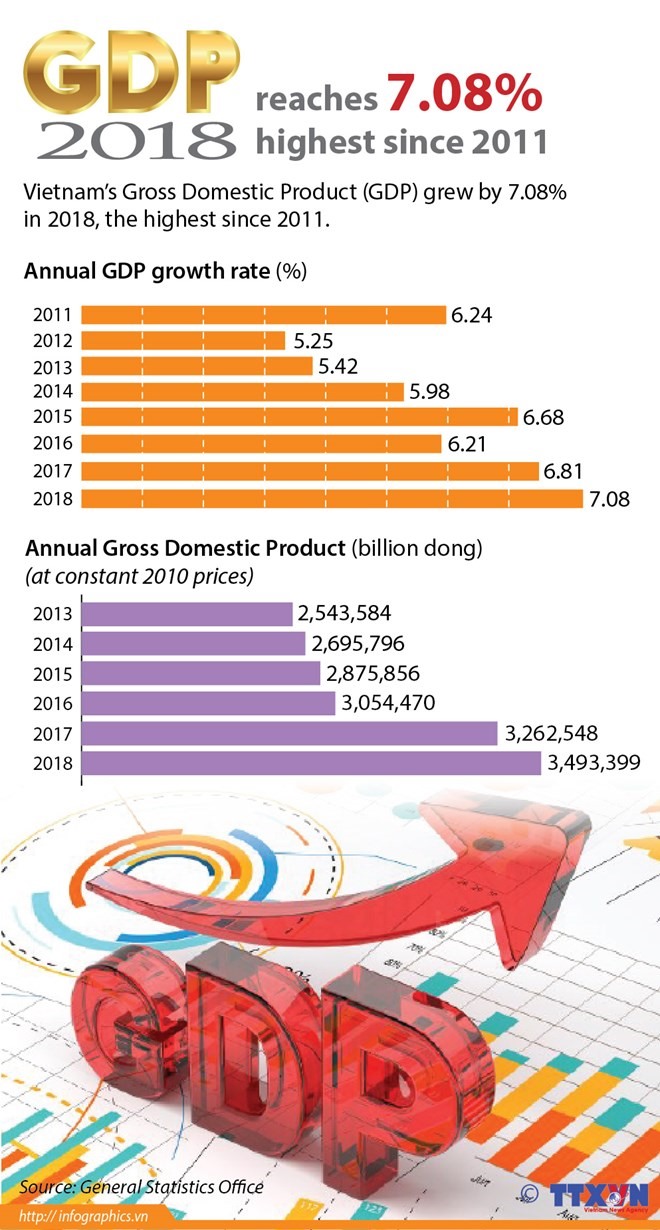At the end of 2018, Viet Nam’s Gross Domestic Product (GDP) – one of the primary indicators used to gauge the health of a country’s economy – was announced by Vietnam General Statistics Office, beating forecasts made by many international institutions.

At the end of 2018, Viet Nam’s Gross Domestic Product (GDP) – one of the primary indicators used to gauge the health of a country’s economy – was announced by Vietnam General Statistics Office, beating forecasts made by many international institutions.
Earlier, the International Monetary Fund (IMF) predicted the country’s 2018 GDP growth rate would stand at 6.6 per cent in its October report titled ‘Asia at the Forefront: Growth Challenges for the Next Decade and Beyond’.
The Australia and New Zealand Banking Group’s Research Unit lowered its projection by 0.2 percentage points to 6.5 per cent.
Though more optimistic, the Asian Development Bank (ADB) still cautiously adjusted its growth forecast from 7.1 per cent to 6.9 per cent for 2018.
In fact, the 2018 figure reached an amazing growth rate of 7.08 per cent, the strongest growth Vietnamese people have seen in 10 years.
However, whether the country is able to maintain such good performance is something experts find hard to say for sure amid the uncertainty and instability of global geopolitics.
Cautious predictions and warning from international institutions are still valid sources of reference for the Government to take into account when implementing its resolution of socio-economic development.
In its October report, the IMF predicted that the global economy would grow at 3.7 per cent in 2019, down 0.2 percentage points from an earlier forecast.
According to the Goldman Sachs Economics Research report in November 2018, the global economy looks poised to slow moderately from 3.8 per cent in 2018 to 3.5 per cent this year, led by deceleration in the US and further softening in China.
An IMF economist admitted that earlier projections appeared to be “overly-optimistic” and “uncertainty is becoming evident at the macro-economic level” given that impacts of the trade wars between the US and trading partners have become more prominent and geopolitical tensions pose further risks.

According to the IMF, rising trade tensions and policy uncertainty could lead firms to postpone or forgo capital spending and hence slow growth in investment and demand. The slowdown would also weaken trade growth.
Disruptions in trade policies are expected to negatively affect global trade flow with volume of goods and services traded this year forecast to grow by 4 per cent, 0.5 percentage points lower than the fund’s earlier estimates.
Goldman Sachs analysts forecast that the trade tensions between the US and China are likely to rise further though the increase in tariff rates on the US$200 billion tranche to 25 per cent has been suspended.
In reality, the slowdown of the Chinese economy has been seen in the third quarter of 2018. The growth of the world’s second largest economy slowed to 6.5 per cent year-on-year in Q3, the weakest pace since the first quarter of 2009, due to slower credit growth and fears about a more damaging trade war with the US weighing on Chinese sentiment.
On the other hand, investors also worry that the Fed would continue to keep the pace of interest rate hikes in 2019. If this is the case, it would lead to significant negative spillover effects for other markets.
Clearly, the gloomy outlook for the world economy still exists.
Meanwhile, Viet Nam has integrated more widely and deeply into the world economy. The more open the Vietnamese economy, the more immediately and immensely it will be affected by changes around the world.
Any rise in trade protectionism would hit Viet Nam. Many countries are now using more non-tariff trade barriers to protect their domestic production like anti-dumping measures and technical requirements of product quality.
Besides, vulnerability in the financial sector to unresolved non-performing loans and undercapitalised banks poses a domestic risk to the outlook. Heightened global financial volatility or disruption of capital flows would have significant spillover into the domestic market.
Though the growth quality has been somehow improved, the economy still relies significantly on labour - intensive manufacturing and processing enterprises in the FDI sector while efficiency of resource allocation is in general still a big question.
Viet Nam’s ability to draw efficient foreign capital flows and compete in the world market is also hampered by low quality of human resources as well as the snail-paced development of science and technology.
Rational targets
Considering the external economic factors above and internal weaknesses of the Vietnamese economy, we find that the GDP target of 6.6-6.8 per cent set for 2019 by the National Assembly is reasonable.
The not-too-ambitious target creates favourable conditions for maintaining macroeconomic stability while creating momentum for the Government to push forward with its structural reform process.
As a matter of fact, we always hope for a high growth rate. But if too much focus is put on reaching a fast-track target, we would likely embrace the idea of promoting the “GDP-generating areas” such as mining and unjustified public investment projects, thereby ignoring the issue of sustainable development or economic restructuring.
Pursuing high GDP growth might allow more involvement of the State – the visible hand – in the economy, whereas we are building a modern institution of a market economy.
Furthermore, it is time for us to change the way we see growth targets. The GDP target should be seen only as a directive indicator rather than a necessary achievement because the indicator depends on various factors, many of which are beyond the State’s control.
Efforts by the Government should also be assessed based on other criteria, not merely the GDP growth rate.
Once again, it is essential to emphasise that the path to sustainable growth will be bumpier in the 12 months ahead. We should keep in mind that despite impressive achievements of the past year, “we cannot rest on our laurels.” — VNS
* Vo Tri Thanh is a senior economist at the Central Institute for Economic Management (CIEM) and a member of the National Financial and Monetary Policy Advisory Council. A doctorate holder in economics from the Australian National University, Thanh mainly undertakes research and provides consultation on issues related to macroeconomic policies, trade liberalisation and international economic integration. Other areas of interest include institutional reforms and financial systems. He authors Viet Nam News’s new column, “Analyst’s Pick.”
|
Different predictions for 2019 GDP growth The ADB in its Asian Development Outlook 2018 Update issued in September last year predicts that Viet Nam’s GDP will increase by 6.8 per cent this year with the US-China trade war still being the main risk for economic prospects. Viet Nam’s GDP is forecast to gradually decline to 6.55 per cent and 6.47 per cent in 2019 and 2020 due to the slowdown in global demand, according to the World Bank. ANZ Viet Nam’s economic outlook report estimates that GDP growth in 2019 will be 7 per cent. The National Centre for Socio-Economic Information and Forecasting (NCIF) offers a much higher prediction than prudent calculations of the World Bank. The growth rate will be in the range of 6.84 to 7.02 per cent for the whole year. — VNS |





